第14章有效资本市场和行为学挑战
- 格式:ppt
- 大小:906.00 KB
- 文档页数:44

有效市场假说与行为金融学的碰撞有效市场假说(Efficient Market Hypothesis, EMH)和行为金融学(Behavioral Finance)是两大金融领域的重要理论。
有效市场假说认为市场是高效的,信息会在瞬息间得到充分反映,投资者都是理性的。
行为金融学则关注人类行为心理学在金融市场中的作用,强调个体投资者常常因为认知偏差和情绪因素而做出非理性的投资决策。
两者在理论和实践中产生了一些碰撞和冲突。
本文将探讨有效市场假说与行为金融学的碰撞,以及在实际投资中如何有效应对。
一、有效市场假说有效市场假说是由尤金·法玛和保罗·萨缪尔逊在上世纪60年代提出的。
其核心观点是,市场中的信息会被迅速反映在证券价格中,价格总是包含了一切可以被了解的信息。
有效市场分为弱式有效市场、半强式有效市场和强式有效市场三种形式。
弱式有效市场假说认为,当前价格包含了所有已公开的历史信息,因此任何技术分析都无法获取超额收益;半强式有效市场假说认为,当前价格包含了所有的历史信息和公共信息,因此基本面分析也无法获取超额收益;强式有效市场假说则认为,市场价格包含了所有信息,包括私有信息,因此任何形式的分析都无法获取超额收益。
在有效市场假说的框架下,投资者都是理性的,都会根据充分的信息来做出投资决策。
他们在市场中所做的任何行为都是理性的,不会受到情绪和认知偏差的影响。
从而,市场价格总是能够充分反映出所有可得信息的价值,任何人都无法通过分析市场价格来获取超额收益。
二、行为金融学行为金融学是对传统金融理论模型的一种批判性重新审视。
行为金融学将经济学与心理学相结合,试图解释投资者的非理性行为,认为投资者常常受到认知偏差和情绪因素的影响而做出非理性的投资决策。
行为金融学家认为,投资者的非理性行为可能导致市场价格与价值发生偏离,从而产生了市场中的“套利机会”。
行为金融学关注投资者的认知偏差和情绪因素对市场的影响。

有效市场假说与行为金融学的碰撞有效市场假设与行为金融学是两种截然不同的理论,它们在金融领域的碰撞引起了人们的广泛关注和讨论。
有效市场假设是指市场上的信息是充分的,投资者能够理性地对这些信息进行分析,并在市场上形成公允的价格。
行为金融学则对这一理论提出了质疑,认为投资者的决策不完全是理性的,而是受到情绪和心理因素的影响。
本文将就有效市场假设和行为金融学的碰撞进行探讨。
我们来介绍一下有效市场假设。
有效市场假设是由尤金·法马提出的,它认为市场上的价格充分反映了各种公开信息,并且投资者对这些信息进行分析后,能够做出最优的投资决策。
有效市场假设包括三种形式:弱式有效市场假设、半强式有效市场假设和强式有效市场假设。
弱式有效市场假设认为市场价格已经充分反映了过去的所有信息,因此技术分析无法获得超额利润;半强式有效市场假设则认为市场价格已经充分反映了所有公开的信息,包括公司的财务报表等,因此基本面分析也无法获得超额利润;强式有效市场假设则认为市场价格已经充分反映了所有的信息,包括公司的内幕消息等,因此任何形式的分析都无法获得超额利润。
行为金融学家认为,投资者在做决策时可能会受到各种认知偏差的影响。
他们可能会出现过度自信和过度乐观的情绪,导致他们高估了某些股票的价值;他们还可能会出现保守偏误,导致他们低估了某些股票的价值。
投资者还可能会受到情绪偏误的影响,例如因为恐惧而出现“卖出低谷”和因为贪婪而出现“买进高峰”的情况。
投资者还可能会出现羊群效应的情况,即他们会跟随其他投资者的行为而做出决策,而不是通过理性的分析。
行为金融学的观点对有效市场假设提出了挑战,因为它表明了市场上的价格并不总是充分反映了所有的信息。
事实上,行为金融学家已经提出了很多关于市场价格形成的行为学证据,来表明投资者的行为并不总是理性的。
他们发现市场上的股票价格有时会出现明显的过度波动,这些波动并不能通过已知的信息来解释。
他们还发现市场上的股票价格会出现明显的不连续性,即股票价格会在短时间内发生剧烈的变化,这些变化同样也不能通过已知的信息来解释。
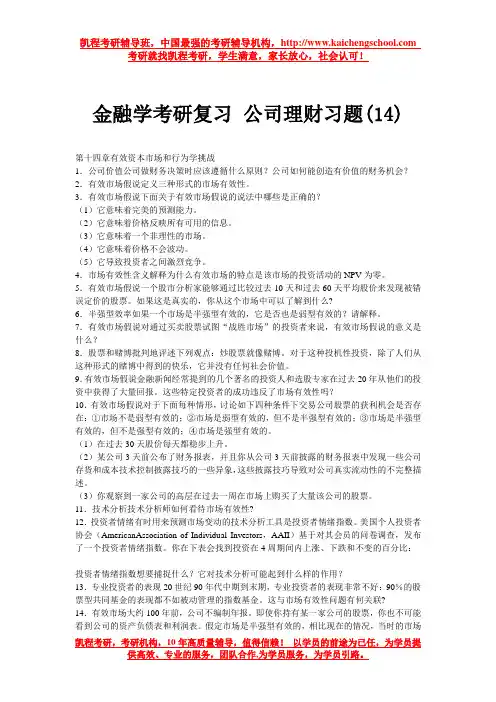
金融学考研复习公司理财习题(14)第十四章有效资本市场和行为学挑战1.公司价值公司做财务决策时应该遵循什么原则?公司如何能创造有价值的财务机会?2.有效市场假说定义三种形式的市场有效性。
3.有效市场假说下面关于有效市场假说的说法中哪些是正确的?(1)它意味着完美的预测能力。
(2)它意味着价格反映所有可用的信息。
(3)它意味着一个非理性的市场。
(4)它意味着价格不会波动。
(5)它导致投资者之间激烈竞争。
4.市场有效性含义解释为什么有效市场的特点是该市场的投资活动的NPV为零。
5.有效市场假说一个股市分析家能够通过比较过去10天和过去60天平均股价来发现被错误定价的股票。
如果这是真实的,你从这个市场中可以了解到什么?6.半强型效率如果一个市场是半强型有效的,它是否也是弱型有效的?请解释。
7.有效市场假说对通过买卖股票试图“战胜市场”的投资者来说,有效市场假说的意义是什么?8.股票和赌博批判地评述下列观点:炒股票就像赌博。
对于这种投机性投资,除了人们从这种形式的赌博中得到的快乐,它并没有任何社会价值。
9.有效市场假说金融新闻经常提到的几个著名的投资人和选股专家在过去20年从他们的投资中获得了大量回报。
这些特定投资者的成功违反了市场有效性吗?10.有效市场假说对于下面每种情形,讨论如下四种条件下交易公司股票的获利机会是否存在:①市场不是弱型有效的;②市场是弱型有效的,但不是半强型有效的;③市场是半强型有效的,但不是强型有效的;④市场是强型有效的。
(1)在过去30天股价每天都稳步上升。
(2)某公司3天前公布了财务报表,并且你从公司3天前披露的财务报表中发现一些公司存货和成本技术控制披露技巧的一些异象,这些披露技巧导致对公司真实流动性的不完整描述。
(3)你观察到一家公司的高层在过去一周在市场上购买了大量该公司的股票。
11.技术分析技术分析师如何看待市场有效性?12.投资者情绪有时用来预测市场变动的技术分析工具是投资者情绪指数。
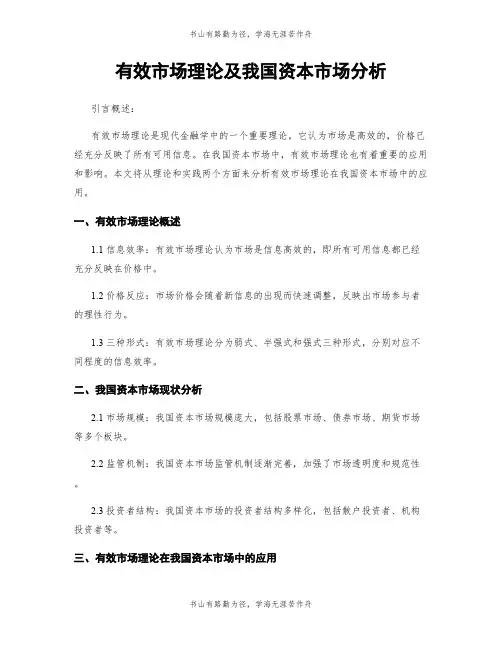
有效市场理论及我国资本市场分析引言概述:有效市场理论是现代金融学中的一个重要理论,它认为市场是高效的,价格已经充分反映了所有可用信息。
在我国资本市场中,有效市场理论也有着重要的应用和影响。
本文将从理论和实践两个方面来分析有效市场理论在我国资本市场中的应用。
一、有效市场理论概述1.1 信息效率:有效市场理论认为市场是信息高效的,即所有可用信息都已经充分反映在价格中。
1.2 价格反应:市场价格会随着新信息的出现而快速调整,反映出市场参与者的理性行为。
1.3 三种形式:有效市场理论分为弱式、半强式和强式三种形式,分别对应不同程度的信息效率。
二、我国资本市场现状分析2.1 市场规模:我国资本市场规模庞大,包括股票市场、债券市场、期货市场等多个板块。
2.2 监管机制:我国资本市场监管机制逐渐完善,加强了市场透明度和规范性。
2.3 投资者结构:我国资本市场的投资者结构多样化,包括散户投资者、机构投资者等。
三、有效市场理论在我国资本市场中的应用3.1 市场反应速度:我国资本市场价格反应速度相对较快,新信息会迅速反映在股价中。
3.2 投资者行为:我国资本市场投资者行为更加理性,更倾向于基于信息进行投资决策。
3.3 市场波动:我国资本市场存在一定程度的市场波动,但整体上仍然表现出一定的有效性。
四、我国资本市场存在的问题及挑战4.1 市场操纵:我国资本市场存在一定程度的市场操纵行为,影响了市场的有效性。
4.2 信息不对称:我国资本市场中信息不对称现象比较严重,影响了市场的信息效率。
4.3 法律法规:我国资本市场法律法规体系仍需进一步完善,以保障市场的公平和透明。
五、未来发展趋势及建议5.1 技术创新:未来我国资本市场可通过技术创新提升市场效率,如区块链、人工智能等技术的应用。
5.2 监管加强:加强市场监管,规范市场秩序,提高市场透明度和公平性。
5.3 投资者教育:加强投资者教育,提高投资者的理财意识和风险意识,促进市场的健康发展。
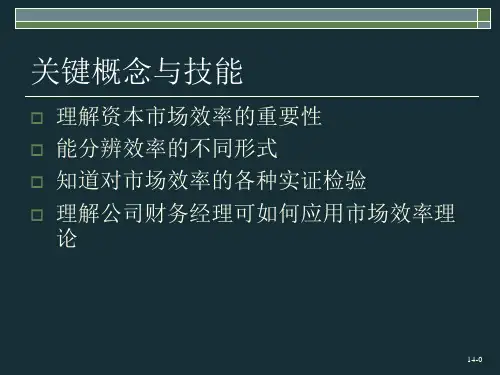


第十四章:有效资本市场和行为学挑战1. To create value, firms should accept financing proposals with positive net present values. Firms can create valuable financing opportunities in three ways: 1) Fool investors. A firm can issue a complex security to receive more than the fair market value. Financial managers attempt to package securities to receive the greatest value. 2) Reduce costs or increase subsidies. A firm can package securities to reduce taxes. Such a security will increase the value of the firm. In addition, financing techniques involve many costs, such as accountants, lawyers, and investment bankers. Packaging securities in a way to reduce these costs will also increase the value of the firm. 3) Create a new security. A previously unsatisfied investor may pay extra for a specialized security catering to his or her needs. Corporations gain from developing unique securities by issuing these securities at premium prices.2. The three forms of the efficient markets hypothesis are: 1) Weak form. Market prices reflect information contained in historical prices. Investors are unable to earn abnormal returns using historical prices to predict future price movements. 2) Semi-strong form. In addition to historical data, market prices reflect all publicly-available information. Investors with insider, or private information, are able to earn abnormal returns. 3) Strong form. Market prices reflect all information, public or private. Investors are unable to earn abnormal returns using insider information or historical prices to predict future price movements.3. a. False. Market efficiency implies that prices reflect all available information, but it does not imply certain knowledge. Many pieces of information that are available and reflected in prices are fairly uncertain. Efficiency of markets does not eliminate that uncertainty and therefore does not imply perfect forecasting ability.b. True. Market efficiency exists when prices reflect all available information. To be efficient in the weak form, the market must incorporate all historical data into prices. Under thesemi-strong form of the hypothesis, the market incorporates all publicly-available information in addition to the historical data. In strong form efficient markets, prices reflect all publicly and privately available information.c. False. Market efficiency implies that market participants are rational. Rational people will immediately act upon new information and will bid prices up or down to reflect that information.d. False. In efficient markets, prices reflect all available information. Thus, prices will fluctuate whenever new information becomes available.e. True. Competition among investors results in the rapid transmission of new market information. In efficient markets, prices immediately reflect new information as investors bid the stock price up or down.4. On average, the only return that is earned is the required return—investors buy assets with returns in excess of the required return (positive NPV), bidding up the price and thus causing the return to fall to the required return (zero NPV); investors sell assets with returns less than the required return (negative NPV), driving the price lower and thus causing the return to rise to the required return (zero NPV).5. The market is not weak form efficient.6. Yes, historical information is also public information; weak form efficiency is a subset of semi-strong form efficiency.7. Ignoring trading costs, on average, such investors merely earn what the market offers; thetrades all have zero NPV. If trading costs exist, then these investors lose by the amount of the costs.8. Unlike gambling, the stock market is a positive sum game; everybody can win. Also, speculators provide liquidity to markets and thus help to promote efficiency.9. The EMH only says, within the bounds of increasingly strong assumptions about the information processing of investors, that assets are fairly priced. An implication of this is that, on average, the typical market participant cannot earn excessive profits from a particular trading strategy. However, that does not mean that a few particular investors cannot outperform the market over a particular investment horizon. Certain investors who do well for a period of time get a lot of attention from the financial press, but the scores of investors who do not do well over the same period of time generally get considerably less attention from the financial press.10. a. If the market is not weak form efficient, then this information could be acted on and a profit earned from following the price trend. Under (2), (3), and (4), this information is fully impounded in the current price and no abnormal profit opportunity exists.b. Under (2), if the market is not semi-strong form efficient, then this information could be used to buy the stock ―cheap‖before the rest of the market discovers the financial statement anomaly. Since (2) is stronger than (1), both imply that a profit opportunity exists; under (3) and (4), this information is fully impounded in the current price and no profit opportunity exists.c. Under (3), if the market is not strong form efficient, then this information could be used as a profitable trading strategy, by noting the buying activity of the insiders as a signal that the stock is underpriced or that good news is imminent. Since (1) and (2) are weaker than (3), all three imply that a profit opportunity exists. Note that this assumes the individual who sees the insider trading is the only one who sees the trading. If the information about the trades made by company management is public information, it will be discounted in the stock price and no profit opportunity exists. Under (4), this information does not signal any profit opportunity for traders; any pertinent information the manager-insiders may have is fully reflected in the current share price.11. A technical analyst would argue that the market is not efficient. Since a technical analyst examines past prices, the market cannot be weak form efficient for technical analysis to work. If the market is not weak form efficient, it cannot be efficient under stronger assumptions about the information available.12. Investor sentiment captures the mood of the investing public. If investors are bearish in general, it may be that the market is headed down in the future since investors are less likely to invest. If the sentiment is bullish, it would be taken as a positive signal to the market. To use investor sentiment in technical analysis, you would probably want to construct a ratio such as a bulls/bears ratio. To use the ratio, simply compare the historical ratio to the market to determine if a certain level on the ratio indicates a market upturn or downturn. Of course, there is a group of investors called contrarians who view the market signals as reversed. That is, if the number of bearish investors reaches a certain level, the market will head up. For a contrarian, these signals are reversed.13. Taken at face value, this fact suggests that markets have become more efficient. The increasing ease with which information is available over the Internet lends strength to thisconclusion. On the other hand, during this particular period, large-capitalization growth stocks were the top performers. Value-weighted indexes such as the S&P 500 are naturally concentrated in such stocks, thus making them especially hard to beat during this period. So, it may be that the dismal record compiled by the pros is just a matter of bad luck or benchmark error.14. It is likely the market has a better estimate of the stock price, assuming it is semistrong form efficient. However, semistrong form efficiency only states that you cannot easily profit from publicly available information. If financial statements are not available, the market can still price stocks based upon the available public information, limited though it may be. Therefore, it may have been as difficult to examine the limited public information and make an extra return.15. a. Aerotech‘s stock price should rise immediately after the announcement of the positive news.b. Only scenario (ii) indicates market efficiency. In that case, the price of the stock rises immediately to the level that reflects the new information, eliminating all possibility of abnormal returns. In the other two scenarios, there are periods of time during which an investor could trade on the information and earn abnormal returns.16. False. The stock price would have adjusted before the founder‘s death only if investors had perfect forecasting ability. The 12.5 percent increase in the stock price aft er the founder‘s death indicates that either the market did not anticipate the death or that the market had anticipated it imperfectly. However, the market reacted immediately to the new information, implying efficiency. It is interesting that the stock price rose after the announcement of the founder‘s death. This price behavior indicates that the market felt he was a liability to the firm.17. The announcement should not deter investors from buying UPC‘s stock. If the market is semi-strong form efficient, the stock price will have already reflected the present value of the payments that UPC must make. The expected return after the announcement should still be equal to the expected return before the announcement. UPC‘s current stockholders bear the burden of the loss, since the stock price falls on the announcement. After the announcement, the expected return moves back to its original level.18. The market is often considered to be relatively efficient up to the semi-strong form. If so, no systematic profit can be made by trading on publicly-available information. Although illegal, the lead engineer of the device can profit from purchasing the firm‘s stock before the news release on the implementation of the new technology. The price should immediately and fully adjust to the new information in the article. Thus, no abnormal return can be expected from purchasing after the publication of the article.19. Under the semi-strong form of market efficiency, the stock price should stay the same. The accounting system changes are publicly available information. Investors would identify no changes in either the firm‘s current or its future cash flows. Thus, the stock price will not change after the announcement of increased earnings.20. Because the number of subscribers has increased dramatically, the time it takes for information in the newsletter to be reflected in prices has shortened. With shorter adjustment periods, it becomes impossible to earn abnormal returns with the information provided by Durkin. If Durkin is using only publicly-available information in its newsletter, its ability topick stocks is inconsistent with the efficient markets hypothesis. Under the semi-strong form of market efficiency, all publicly-available information should be reflected in stock prices. The use of private information for trading purposes is illegal.21. You should not agree with your broker. The performance ratings of the small manufacturing firms were published and became public information. Prices should adjust immediately to the information, thus preventing future abnormal returns.22. Stock prices should immediately and fully rise to reflect the announcement. Thus, one cannot expect abnormal returns following the announcement.23. a. No. Earnings information is in the public domain and reflected in the current stock price.b. Possibly. If the rumors were publicly disseminated, the prices would have already adjusted for the possibility of a merger. If the rumor is information that you received from an insider, you could earn excess returns, although trading on that information is illegal.c. No. The information is already public, and thus, already reflected in the stock price.24. Serial correlation occurs when the current value of a variable is related to the future value of the variable. If the market is efficient, the information about the serial correlation in the macroeconomic variable and its relationship to net earnings should already be reflected in the stock price. In other words, although there is serial correlation in the variable, there will not be serial correlation in stock returns. Therefore, knowledge of the correlation in the macroeconomic variable will not lead to abnormal returns for investors.25. The statement is false because every investor has a different risk preference. Although the expected return from every well-diversified portfolio is the same after adjusting for risk, investors still need to choose funds that are consistent with their particular risk level.26. The share price will decrease immediately to reflect the new information. At the time of the announcement, the price of the stock should immediately decrease to reflect the negative information.27. In an efficient market, the cumulative abnormal return (CAR) for Prospectors would rise substantially at the announcement of a new discovery. The CAR falls slightly on any day when no discovery is announced. There is a small positive probability that there will be a discovery on any given day. If there is no discovery on a particular day, the price should fall slightly because the good event did not occur. The substantial price increases on the rare days of discovery should balance the small declines on the other days, leaving CARs that are horizontal over time.28. Behavioral finance attempts to explain both the 1987 stock market crash and the Internet bubble by changes in investor sentiment and psychology. These changes can lead to non-random price behavior.。
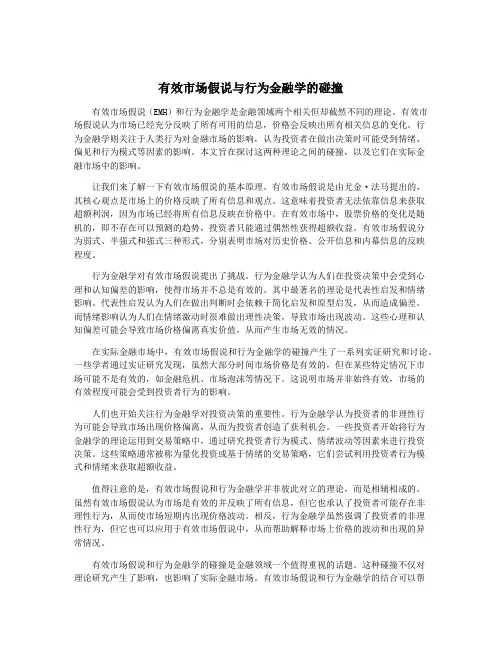
有效市场假说与行为金融学的碰撞有效市场假说(EMH)和行为金融学是金融领域两个相关但却截然不同的理论。
有效市场假说认为市场已经充分反映了所有可用的信息,价格会反映出所有相关信息的变化。
行为金融学则关注于人类行为对金融市场的影响,认为投资者在做出决策时可能受到情绪、偏见和行为模式等因素的影响。
本文旨在探讨这两种理论之间的碰撞,以及它们在实际金融市场中的影响。
让我们来了解一下有效市场假说的基本原理。
有效市场假说是由尤金·法马提出的,其核心观点是市场上的价格反映了所有信息和观点。
这意味着投资者无法依靠信息来获取超额利润,因为市场已经将所有信息反映在价格中。
在有效市场中,股票价格的变化是随机的,即不存在可以预测的趋势,投资者只能通过偶然性获得超额收益。
有效市场假说分为弱式、半强式和强式三种形式,分别表明市场对历史价格、公开信息和内幕信息的反映程度。
行为金融学对有效市场假说提出了挑战。
行为金融学认为人们在投资决策中会受到心理和认知偏差的影响,使得市场并不总是有效的。
其中最著名的理论是代表性启发和情绪影响。
代表性启发认为人们在做出判断时会依赖于简化启发和原型启发,从而造成偏差。
而情绪影响认为人们在情绪激动时很难做出理性决策,导致市场出现波动。
这些心理和认知偏差可能会导致市场价格偏离真实价值,从而产生市场无效的情况。
在实际金融市场中,有效市场假说和行为金融学的碰撞产生了一系列实证研究和讨论。
一些学者通过实证研究发现,虽然大部分时间市场价格是有效的,但在某些特定情况下市场可能不是有效的,如金融危机、市场泡沫等情况下。
这说明市场并非始终有效,市场的有效程度可能会受到投资者行为的影响。
人们也开始关注行为金融学对投资决策的重要性。
行为金融学认为投资者的非理性行为可能会导致市场出现价格偏离,从而为投资者创造了获利机会。
一些投资者开始将行为金融学的理论运用到交易策略中,通过研究投资者行为模式、情绪波动等因素来进行投资决策。
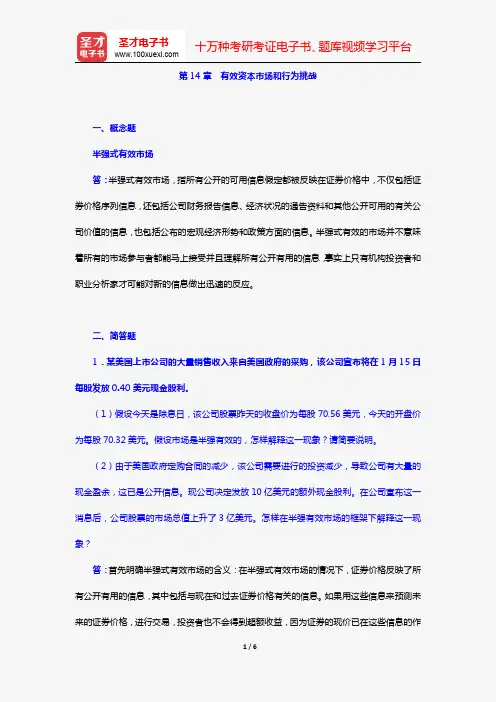
第14章有效资本市场和行为挑战一、概念题半强式有效市场答:半强式有效市场,指所有公开的可用信息假定都被反映在证券价格中,不仅包括证券价格序列信息,还包括公司财务报告信息、经济状况的通告资料和其他公开可用的有关公司价值的信息,也包括公布的宏观经济形势和政策方面的信息。
半强式有效的市场并不意味着所有的市场参与者都能马上接受并且理解所有公开有用的信息,事实上只有机构投资者和职业分析家才可能对新的信息做出迅速的反应。
二、简答题1.某美国上市公司的大量销售收入来自美国政府的采购,该公司宣布将在1月15日每股发放0.40美元现金股利。
(1)假设今天是除息日,该公司股票昨天的收盘价为每股70.56美元,今天的开盘价为每股70.32美元。
假设市场是半强有效的,怎样解释这一现象?请简要说明。
(2)由于美国政府定购合同的减少,该公司需要进行的投资减少,导致公司有大量的现金盈余,这已是公开信息。
现公司决定发放10亿美元的额外现金股利。
在公司宣布这一消息后,公司股票的市场总值上升了3亿美元。
怎样在半强有效市场的框架下解释这一现象?答:首先明确半强式有效市场的含义:在半强式有效市场的情况下,证券价格反映了所有公开有用的信息,其中包括与现在和过去证券价格有关的信息。
如果用这些信息来预测未来的证券价格,进行交易,投资者也不会得到超额收益,因为证券的现价已在这些信息的作用下得到充分的反映,只有那些利用内幕信息者才能获得非正常的回报。
因此,只有加强对内幕信息的管束,杜绝内幕交易,才能符合“公开、公正、公平”原则的有效市场要求。
(1)公司除息日前一天的股价是70.56元,因为市场是半强式的,所以公司宣布发放每股0.40元现金股利的消息为公开消息,那么在除息日的股价开盘价应为:70.56-0.40=70.16元;但由于在除息日股价会下调,所以人们会有一个错觉;认为股票变得价格低而值得买,因此有“炒除息”的说法。
一些投资者会在股票除息当日买入该股,然后等股价反弹再卖出套现获利。
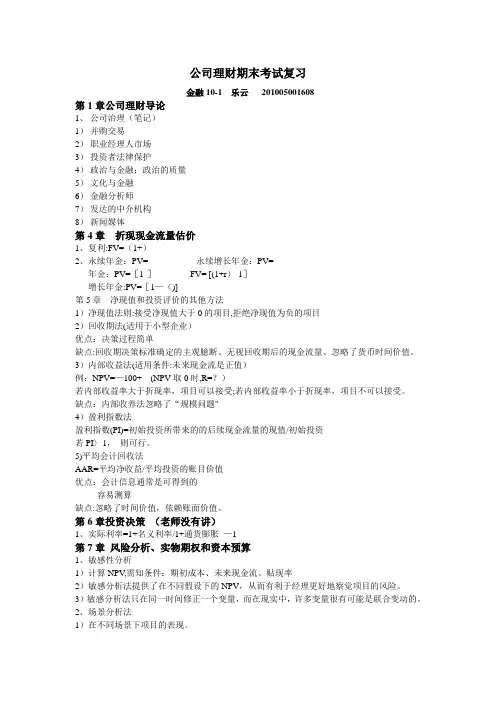
公司理财期末考试复习金融10-1 乐云201005001608第1章公司理财导论1、公司治理(笔记)1)并购交易2)职业经理人市场3)投资者法律保护4)政治与金融;政治的质量5)文化与金融6)金融分析师7)发达的中介机构8)新闻媒体第4章折现现金流量估价1、复利:FV=(1+)2、永续年金:PV= 永续增长年金:PV=年金:PV=[1-]FV= [(1+r)-1]增长年金:PV=[1—()]第5章净现值和投资评价的其他方法1)净现值法则:接受净现值大于0的项目,拒绝净现值为负的项目2)回收期法(适用于小型企业)优点:决策过程简单缺点:回收期决策标准确定的主观臆断、无视回收期后的现金流量、忽略了货币时间价值。
3)内部收益法(适用条件:未来现金流是正值)例:NPV=—100+ (NPV取0时,R=?)若内部收益率大于折现率,项目可以接受;若内部收益率小于折现率,项目不可以接受。
缺点:内部收养法忽略了“规模问题"4)盈利指数法盈利指数(PI)=初始投资所带来的的后续现金流量的现值/初始投资若PI〉1,则可行。
5)平均会计回收法AAR=平均净收益/平均投资的账目价值优点:会计信息通常是可得到的容易测算缺点:忽略了时间价值,依赖账面价值。
第6章投资决策(老师没有讲)1、实际利率=1+名义利率/1+通货膨胀—1第7章风险分析、实物期权和资本预算1、敏感性分析1)计算NPV,需知条件:期初成本、未来现金流、贴现率2)敏感分析法提供了在不同假设下的NPV,从而有利于经理更好地察觉项目的风险。
3)敏感分析法只在同一时间修正一个变量,而在现实中,许多变量很有可能是联合变动的。
2、场景分析法1)在不同场景下项目的表现。
2)操作性不强3、盈亏平衡法1)计算出项目盈亏平衡时所应实现的销售量2)帮助经理了解项目在亏损前做出错误的预测的危害性3)适用于工业4、实物期权1)拓展期权2)放弃期权3)择机期权5、决策树是对项目中的隐含期权和实物期权进行评估的方法。
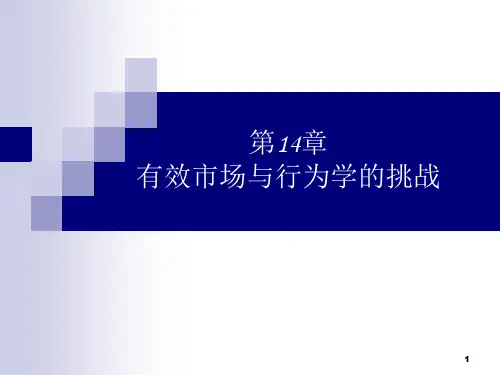
有效市场假说与行为金融学的碰撞有效市场假说(EMH)和行为金融学是金融领域内两种截然不同的理论。
有效市场假说主张市场上的所有信息都被及时地准确地反映在证券价格之中,而行为金融学则认为投资者的情绪和行为会影响证券价格的形成。
这两种理论的碰撞造成了金融学界关于市场是否有效的争论,也促进了对市场行为和投资者行为的深入研究。
本文将从不同角度探讨有效市场假说和行为金融学的碰撞,并分析对金融市场的影响。
一、有效市场假说有效市场假说是由尤金·法玛在20世纪60年代提出的。
该假说认为,市场上的所有信息都被及时地准确地反映在证券价格之中,投资者不能依靠信息获取超额利润。
有效市场假说分为弱式、半强式和强式三种形式,分别代表了市场对历史价格、所有公开信息以及所有信息的反映程度。
有效市场假说的核心观点是市场价格具有随机性,无法预测。
投资者应当采取被动的投资策略,即持有整个市场的投资组合,而不是试图寻找低估和高估的个别股票。
这种观点引发了巨大的争论,一些学者和投资者对有效市场假说提出了质疑。
二、行为金融学行为金融学是对有效市场假说的一种反思。
行为金融学认为,投资者的情绪和行为会影响证券价格的形成。
投资者在面对利好消息时往往会过度乐观,而在面对利空消息时则会过度悲观,导致证券价格过度波动。
行为金融学还提出了许多行为偏差的概念,例如过度自信、错觉风险和羊群行为等,这些都会影响投资者的决策和行为。
行为金融学的观点对传统金融理论提出了挑战,也引发了金融学界的关注。
在行为金融学的框架下,投资者的决策不再是理性的,而是受到多种心理和社会因素的影响。
这一观点对金融市场的理解和投资策略提出了新的挑战。
在实际金融市场中,有效市场假说和行为金融学两种观点均有其道理。
从理论上来说,有效市场假说提出了一个理想化的市场,而行为金融学则更贴近实际市场的情况。
有效市场假说对于市场的随机性和信息的反映有其合理性。
市场上的信息确实会被大部分投资者及时准确地反映在证券价格之中,这也是市场效率的基础。
有效市场假说与行为金融学的碰撞1. 引言1.1 背景介绍有效市场假说与行为金融学是金融学领域两个重要且具有争议的理论。
有效市场假说认为市场是高度有效的,即市场上的资产价格已经包含了所有可获得的信息,投资者不能通过研究市场的信息来获得超额收益。
而行为金融学则认为市场参与者并不总是理性的,他们的投资决策可能受到情绪、认知偏差等因素的影响,导致市场价格偏离其内在价值。
这两种理论的碰撞,引发了对金融市场运行机制的探讨和思考。
在实践中,投资者们往往面临着如何在信息泛滥的市场中做出正确的投资决策的难题。
研究有效市场假说与行为金融学的冲突,对于揭示市场行为的规律、指导投资者的决策具有重要的理论和实践意义。
本文将对有效市场假说和行为金融学进行系统的梳理和比较,分析二者的异同点,探讨有效市场假说与行为金融学的冲突所在,以及市场行为的影响因素。
通过案例分析,深入剖析市场参与者的投资行为,并就此对投资决策提出启示。
对未来研究方向进行展望,希望能够为金融领域的研究和实践提供一定的参考。
1.2 研究目的研究目的是探讨有效市场假说与行为金融学之间的碰撞和冲突,分析市场中投资者行为的影响因素。
通过比较两种理论的观点和实证研究,深入探讨市场价格是否能够有效反映全部信息,以及投资者在决策过程中是否存在心理偏差和风险偏好。
试图从不同的理论角度解释市场波动和价格异常现象,并借助实证案例对市场行为进行深入分析。
通过本研究的开展,旨在为投资者提供更科学、全面的投资决策依据,为市场监管部门提供参考,促进资本市场的健康发展和投资效率的提升。
1.3 研究意义研究意义:有效市场假说与行为金融学作为金融领域中两大重要学说,其碰撞与冲突引发了学术界和实践界的广泛关注。
研究这一问题的意义主要体现在以下几个方面:深入研究有效市场假说与行为金融学的碰撞,有助于拓展我们对金融市场行为规律的认识。
有效市场假说认为市场价格已经充分反映了全部可得信息,而行为金融学则认为投资者的情绪和行为会导致市场价格偏离价值。
有效市场理论及我国资本市场分析有效市场理论是指资本市场上的证券价格反映了所有可获得的信息,并且这些信息被合理地反映在证券价格中。
在有效市场中,投资者无法通过分析市场数据或利用其他信息来获得超额利润,因为证券价格已经充分反映了所有可获得的信息。
我国资本市场是指中国境内的证券交易市场,包括股票市场、债券市场和期货市场等。
在我国资本市场中,有效市场理论的应用受到了一些限制,主要体现在以下几个方面:1.信息不对称:我国资本市场存在信息不对称的问题,即一些市场参与者拥有更多、更准确的信息,而其他投资者则无法获得这些信息。
这导致市场上的交易不完全公平,一些投资者可能通过内幕信息获取超额利润。
2.市场操纵:我国资本市场中存在一些市场操纵行为,例如虚假宣传、内幕交易等。
这些行为会扰乱市场的正常运行,使得证券价格不能充分反映所有可获得的信息。
3.市场监管:我国资本市场的监管力度相对较弱,监管制度和执法手段还有待进一步完善。
这导致一些违法行为难以被及时发现和打击,进一步影响了市场的有效性。
尽管存在以上限制,我国资本市场仍然在不断发展壮大,并逐渐接近有效市场的要求。
以下是我国资本市场的一些特点和数据分析:1.股票市场:我国股票市场分为上海证券交易所和深圳证券交易所两个主要交易所。
截至目前,我国股票市场上市公司数量已超过4000家,总市值超过60万亿元人民币。
其中,金融、房地产和制造业是股票市场的主要板块。
2.债券市场:我国债券市场包括政府债券、企业债券和金融债券等。
截至目前,我国债券市场规模已超过100万亿元人民币。
债券市场的发展有助于提供长期资金和降低企业融资成本。
3.期货市场:我国期货市场包括商品期货和金融期货两个主要品种。
截至目前,我国期货市场已经涵盖了农产品、能源、金属等多个领域,交易量和参与者数量也在不断增加。
4.投资者结构:我国资本市场的投资者结构相对复杂,包括个人投资者、机构投资者和外资等。
个人投资者是市场的主要参与者,但由于信息不对称和投资能力的限制,个人投资者往往难以取得良好的投资回报。